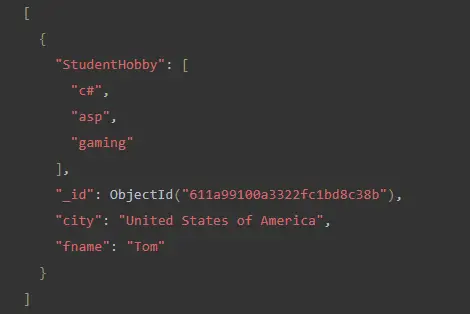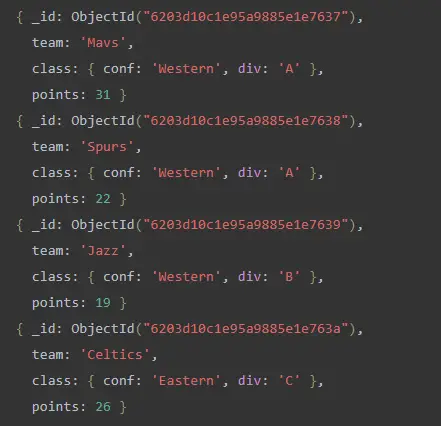Check if a field exists in MongoDB
This article will tell you about all the fields in a database and how to check if they exist. In addition, you will learn how to check if an embedded field exists in a database.
Fields in the database
A field is a physical structure that holds data in a form, file, or database. A field contains one or more bytes.
Data records include order number, name, address, city, etc. The two words 搜索字段and 搜索框are often used interchangeably on web pages.
For database searches, this field is the common denominator. For example, when you run a database query to find the 居住在某个国家/地区的所有客户, the column is used STATE.
ORDER AMOUNTField is used to total when aggregating transactions. When looking for a specific employee, use JOB TITLE.
Fields in MongoDB
In MongoDB, each document stored in a collection requires a unique _idprimary key field. If the inserted document omits _idthe field, the MongoDB driver automatically _idgenerates one for the field ObjectId.
Check if field exists in MongoDB
$existsThe operator
in MongoDB can be used to verify the existence of a field in a given collection. When $existsthe value of the operator is set to true, it matches documents that contain the provided field (including documents where the value of that field is empty).
When $existsthe value of the operator is false, this operator returns only documents that do not contain the given field.
grammar:
{ field: { $exists: <boolean> } }
When <boolean>is true, $existsmatches documents that contain the field, including nulldocuments where the field value is . If <boolean>is false, the query returns only documents that do not contain the field.
MongoDB $existsdoes not correspond to the SQL _ operator exists. For SQL _ exists, use $inthe _ operator.
$inThe operator finds documents where a field value is equal to any of the values in the provided array. Use the following prototype to provide $inan expression.
{ field: { $in: [<value1>, <value2>, ... <valueN> ] } }
In MongoDB, you can use the following method to check if a field exists in a collection.
Check if a field exists in a MongoDB collection
db.data.find({ "myField": { $exists: true } })
This method determines myFieldif exists in datathe collection. If it does, it returns all documents that contain the field name. If not, it returns nothing.
example:
db={
"data": [
{
"_id": ObjectId("611a99100a3322fc1bd8c38b"),
"fname": "Tom",
"city": "United States of America",
"StudentHobby": [
"c#",
"asp",
"gaming"
]
},
{
"_id": ObjectId("611a99340a3322fc1bd8c38c"),
"fname": "Harry",
"city": "Canada",
"courses": [
"python",
"asp",
"node"
]
},
{
"_id": ObjectId("611a99510a3322fc1bd8c38d"),
"fname": "Mikky",
"city": "New Zealand",
"courses": [
"python",
"asp",
"c++"
]
},
{
"_id": ObjectId("611b3e88a60b5002406571c3"),
"fname": "Ron",
"city": "United Kingdom",
"courses": [
"python",
"django",
"node"
]
}
]
}
The database configuration is as above; StudentHobbythe query to check whether the field exists is:
db.data.find({ 'StudentHobby' : { '$exists' : true }})The results of this query are shown in the following screenshot.

Check if embedded field exists in MongoDB
db.data.find({ "myField.embeddedField": { $exists: true } })
This method determines whether myFieldthe fields in the field are present in the collection.embeddedFielddata
If yes, it returns all documents containing the field name. If no, it returns nothing.
The database configuration for the above query is:
db.teams.insertOne({team: "Mavs", class: {conf:"Western", div:"A"}, points: 31})
db.teams.insertOne({team: "Spurs", class: {conf:"Western", div:"A"}, points: 22})
db.teams.insertOne({team: "Jazz", class: {conf:"Western", div:"B"}, points: 19})
db.teams.insertOne({team: "Celtics", class: {conf:"Eastern", div:"C"}, points: 26})
The following code will show divwhether the embedded field name exists in teamsthe fields in collection class.
db.teams.find({ "class.div": { $exists: true } })
The results of this query are shown in the following screenshot.

Since the embedded field name divexists in classthe field, divevery document containing the embedded field is returned.
When a field does not exist in MongoDB
db={
"data": [
{
"_id": ObjectId("611a99100a3322fc1bd8c38b"),
"fname": "Tom",
"city": "United States of America",
"StudentHobby": [
"c#",
"asp",
"gaming"
]
},
{
"_id": ObjectId("611a99340a3322fc1bd8c38c"),
"fname": "Harry",
"city": "Canada",
"courses": [
"python",
"asp",
"node"
]
},
{
"_id": ObjectId("611a99510a3322fc1bd8c38d"),
"fname": "Mikky",
"city": "New Zealand",
"courses": [
"python",
"asp",
"c++"
]
},
{
"_id": ObjectId("611b3e88a60b5002406571c3"),
"fname": "Ron",
"city": "United Kingdom",
"courses": [
"python",
"django",
"node"
]
}
]
}
If the field doesn't exist, you won't get anything.
db.data.find({ 'StudentTechnicalSubject' : { '$exists' : true }})no document found
The query function of any database management system is crucial to obtain data. Since the databases of large enterprises contain complex data types, they prefer to use queries to access the required data in a timely manner.
Operators are an important part of every query; in this tutorial, you practiced $existsthe operator of MongoDB. You can use this operator to verify the available fields in the document and fetch papers that do not contain the requested fields.
$existsThe functionality of the operators
mentioned above 布尔值is supported by which can be passed.
For reprinting, please send an email to 1244347461@qq.com for approval. After obtaining the author's consent, kindly include the source as a link.
Related Articles
List all collections in MongoDB Shell
Publish Date:2025/04/29 Views:156 Category:MongoDB
-
When using MongoDB , there are several ways to list the collections in the database. This article will discuss four different ways to get a list of collections in a MongoDB database. These methods are as follows: show collections List all c
Querying for non-null values in MongoDB
Publish Date:2025/04/29 Views:139 Category:MongoDB
-
This MongoDB article will explain how to query for non-null values in MongoDB. To query for non-null values, you can use $ne the operator and $eq the operator and then specify the desired value to query. This article shows the readers
Shutting down with code:100 error in MongoDB
Publish Date:2025/04/29 Views:53 Category:MongoDB
-
This MongoDB tutorial will teach you to fix the error on different operating systems shutting down with code:100 . It will also talk about the root cause of why this issue occurs. shutting down with code:100 Errors in MongoDB As we all know
SELECT COUNT GROUP BY in MongoDB
Publish Date:2025/04/29 Views:74 Category:MongoDB
-
In this article, we will discuss the functions in MongoDB. Also, we will point out the aggregation functions in detail. We will explain in detail the different ways to count and sort multiple and single fields of Group in MongoDB. Operation
Differences between MongoDB and Mongoose
Publish Date:2025/04/29 Views:80 Category:MongoDB
-
This MongoDB article will discuss the differences between MongoDB and Mongoose. Unfortunately, most beginners tend to confuse these two concepts when they start developing applications and use MongoDB as their backend. MongoDB has its own s
Install MongoDB using Homebrew
Publish Date:2025/04/29 Views:161 Category:MongoDB
-
MongoDB is a well-known unstructured database management system that can handle large amounts of data. It is a document-oriented database system and belongs to the NoSQL family (non-SQL). Data and records are stored as documents that look a
Create a MongoDB dump of the database
Publish Date:2025/04/29 Views:62 Category:MongoDB
-
In this MongoDB article, you’ll get a walkthrough of Mongodump and Mongorestore , how to use them, and some simple examples of backing up and restoring your collections using both tools. mongodump Commands in MongoDB Mongodump is a tool t
Get the size of the database in MongoDB
Publish Date:2025/04/29 Views:88 Category:MongoDB
-
When working in MongoDB, do you know the size of your database? Today, we will learn how to get the size of a database in MongoDB using show dbs the command and the method. db.stats() Get the size of the database in MongoDB We can show dbs;
Grouping values by multiple fields with MongoDB
Publish Date:2025/04/29 Views:99 Category:MongoDB
-
MongoDB Group by Multiple Fields is used to group values by multiple fields using various methods. One of the most efficient ways to group various fields present in MongoDB documents is by using $group the operator, which helps in per

